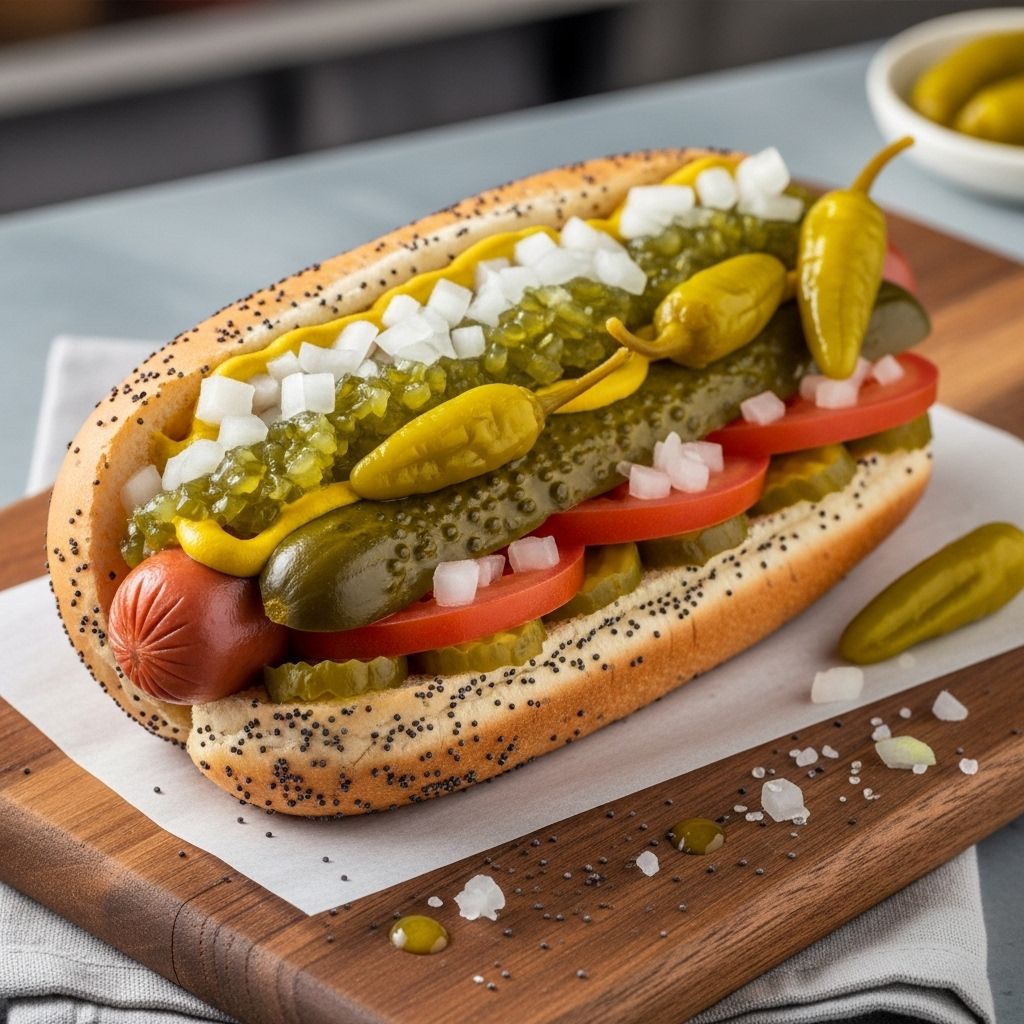Chicago Style Hot Dog Recipe: 7 Toppings For Authentic Taste
Discover the iconic Windy City delicacy with all the traditional toppings and preparation methods

Image: HearthJunction Design Team
Authentic Chicago-Style Hot Dog: The Ultimate Guide
The Chicago-style hot dog stands as one of America’s most distinctive regional food specialties. With its unique combination of toppings and strict adherence to tradition, this iconic street food represents more than just a quick meal—it’s a cultural institution in the Windy City. Whether you’re a Chicago native looking to perfect your technique or an enthusiast wanting to recreate this classic at home, this comprehensive guide will walk you through everything you need to know about crafting the perfect Chicago-style hot dog.
What Makes a Chicago-Style Hot Dog Authentic?
A true Chicago-style hot dog follows a specific formula that locals consider sacred. The classic version features an all-beef frankfurter nestled in a steamed poppy seed bun, then topped with a precisely arranged collection of condiments and vegetables. What’s notably absent from an authentic Chicago dog? Ketchup. Ask for ketchup on your hot dog in Chicago, and you might receive anything from a gentle correction to a playful lecture about hot dog etiquette.
The traditional Chicago hot dog emerged from street vendors during the Great Depression, when vendors at Maxwell Street market created a “depression sandwich” that offered a complete meal in a single, affordable package. Today, hot dog stands throughout Chicago continue to honor this tradition, with only minor variations on the classic formula.
Essential Ingredients for Chicago-Style Hot Dogs
Creating an authentic Chicago-style hot dog requires specific ingredients. While some substitutions can be made in a pinch, purists insist on the traditional components. Here’s what you’ll need:
The Hot Dog
The foundation of any Chicago-style hot dog is an all-beef frankfurter. Vienna Beef is the most iconic brand in Chicago, known for its rich flavor and perfect snap. These hot dogs are typically boiled or steamed rather than grilled, which helps maintain their juicy texture and distinctive flavor profile.
The Bun
An authentic Chicago-style hot dog isn’t complete without a steamed poppy seed bun. In Chicago, S. Rosen’s Mary Ann Poppy Seed Buns are the traditional choice. The steaming process softens the bun while maintaining its structure, creating the perfect vessel for the hot dog and its many toppings.
The Classic Toppings
The traditional Chicago-style hot dog includes a specific arrangement of toppings, often described as being “dragged through the garden” due to its abundant vegetable garnishes:
- Yellow Mustard: A stripe of bright yellow mustard is the first condiment applied.
- Sweet Green Pickle Relish: Chicago-style hot dogs feature a vibrant, neon-green sweet pickle relish that adds both color and flavor.
- Fresh Chopped Onions: White onions, finely chopped, add texture and a sharp bite.
- Tomato Wedges: Fresh, ripe tomato wedges (typically two) are placed along the sides of the hot dog.
- Pickle Spear: A crisp dill pickle spear runs alongside the hot dog, adding crunch and tartness.
- Sport Peppers: These small, spicy pickled peppers are a distinctive element of Chicago-style hot dogs, providing heat.
- Celery Salt: A final dusting of celery salt tops everything off, adding a complex, savory note.
Step-by-Step Instructions for Perfect Chicago-Style Hot Dogs
Follow these detailed steps to create an authentic Chicago-style hot dog experience in your own kitchen:
Preparing the Hot Dogs
While grilling might be your go-to method for cooking hot dogs, traditional Chicago-style dogs are steamed or simmered in hot water. This cooking method ensures a juicy, tender hot dog that complements the array of toppings.
- Fill a pot with enough water to cover the hot dogs and bring it to a simmer (not a rolling boil).
- Add the all-beef hot dogs to the simmering water and cook for about 5-7 minutes until heated through.
- Avoid piercing the hot dogs, as this will allow their flavorful juices to escape.
- Once heated, remove them from the water and briefly pat dry.
Preparing the Buns
The perfectly steamed poppy seed bun is crucial to the Chicago-style hot dog experience:
- Set up a steamer basket over simmering water.
- Place the poppy seed buns in the steamer for 1-2 minutes until warm and soft, but not soggy.
- If you don’t have a steamer, you can wrap the buns in a damp paper towel and microwave them for about 10-15 seconds.
Assembling Your Chicago-Style Hot Dog
Assembly isn’t just about piling on toppings—there’s an art to constructing the perfect Chicago dog:
- Place the steamed hot dog in the warm poppy seed bun.
- Draw a line of yellow mustard along one side of the hot dog.
- Spoon the bright green relish alongside the mustard.
- Sprinkle freshly chopped white onions over the hot dog.
- Tuck two tomato wedges between the hot dog and the side of the bun.
- Place a pickle spear between the hot dog and the opposite side of the bun.
- Add 2-3 sport peppers on top.
- Finish with a light sprinkle of celery salt over everything.
Remember: The proper arrangement of toppings isn’t just about aesthetics—it ensures that each bite contains the perfect balance of flavors and textures that define the Chicago-style hot dog experience.
Regional Variations and Controversial Adaptations
While the classic Chicago-style hot dog has a well-established formula, regional variations and modern adaptations have emerged over the years. Some purists may object, but these variations showcase the evolving nature of this beloved street food.
Char Dogs
Some Chicago establishments offer “char dogs,” which feature a grilled rather than steamed hot dog. This method creates a slightly smoky flavor and caramelized exterior while maintaining the traditional toppings. While not strictly traditional, char dogs have gained significant popularity throughout the city.
The Ketchup Controversy
Perhaps no aspect of Chicago hot dog culture generates more heated debate than the ketchup question. The traditional stance is clear: no ketchup on a Chicago dog. This rule is so ingrained in local culture that many hot dog stands proudly display signs declaring “NO KETCHUP” or offer humorous warnings about requesting the forbidden condiment.
Despite the strong cultural stance against ketchup, many Chicagoans (especially children) enjoy their hot dogs with ketchup. While you wouldn’t specifically order a “Chicago-style” hot dog with ketchup, contrary to popular belief, no laws prevent adding ketchup to your hot dog within city limits. The controversy is more about tradition and culinary identity than strict enforcement.
Serving Suggestions and Accompaniments
While a Chicago-style hot dog can certainly stand on its own as a complete meal, traditional accompaniments enhance the experience:
French Fries
Chicago hot dog stands typically serve their dogs alongside fresh-cut french fries, often piled high and generously salted. For the most authentic experience, serve your Chicago-style hot dogs with thick-cut fries.
Beverages
Traditional beverages to accompany your Chicago-style hot dog include:
- Fountain soda (particularly local Chicago brands like Green River when available)
- Root beer
- Lemon-lime soda
- For adults, a cold beer—preferably a local Chicago brew
Cultural Significance of the Chicago-Style Hot Dog
The Chicago-style hot dog represents more than just a popular street food—it’s deeply embedded in the city’s cultural identity. Hot dog stands serve as neighborhood gathering spots, and locals take pride in introducing visitors to this distinctive culinary tradition.
The hot dog’s origins in Chicago trace back to German and Austrian immigrants who brought their sausage-making traditions to the city. During the Great Depression, vendors at Maxwell Street market created an affordable yet filling meal by loading hot dogs with vegetables and condiments. This “depression sandwich” evolved into today’s Chicago-style hot dog, a testament to the city’s immigrant history and pragmatic approach to food.
Nutritional Considerations
While a Chicago-style hot dog isn’t typically considered health food, it does offer some nutritional benefits compared to other fast food options. The abundance of fresh vegetable toppings provides fiber, vitamins, and minerals that wouldn’t be present in a plain hot dog. For those concerned about nutrition, consider these modifications:
- Opt for lower-sodium hot dogs
- Use whole grain poppy seed buns for added fiber
- Add extra vegetables like cucumber slices for more nutritional value
- Consider turkey or chicken hot dogs as a leaner protein option (though purists might object)
Frequently Asked Questions
Q: Can I grill the hot dogs instead of steaming or boiling them?
A: While traditional Chicago-style hot dogs use steamed or simmered hot dogs, many people enjoy the flavor of grilled dogs. These are sometimes called “char dogs” in Chicago. If you prefer grilling, go ahead—just make sure to include all the traditional toppings.
Q: What if I can’t find sport peppers?
A: Sport peppers can be difficult to find outside of Chicago. Pepperoncini or serrano peppers make acceptable substitutes, though they won’t provide exactly the same flavor profile. You can also order authentic sport peppers online.
Q: Is it really that bad to put ketchup on a Chicago-style hot dog?
A: While Chicago hot dog purists consider ketchup on a hot dog to be a culinary sin, what matters most is enjoying your food. That said, if you want to experience an authentic Chicago-style hot dog, try it without ketchup at least once to appreciate the traditional flavor combination.
Q: Can I make a vegetarian version of a Chicago-style hot dog?
A: Absolutely! Vegetarian or vegan hot dogs can be substituted while maintaining all the traditional toppings. Many Chicago hot dog stands now offer plant-based options to accommodate various dietary preferences.
Q: How do I store leftover prepared Chicago-style hot dogs?
A: Chicago-style hot dogs are best enjoyed fresh. If you need to store leftovers, keep the components separate—refrigerate the cooked hot dogs, and store the toppings individually. Reassemble just before eating.
Whether you’re a Chicago native missing a taste of home or simply curious about this iconic American street food, creating authentic Chicago-style hot dogs at home allows you to experience a beloved culinary tradition. By following the guidelines in this comprehensive guide, you’ll be able to recreate the distinctive flavors and textures that have made the Chicago-style hot dog famous worldwide. Remember, it’s not just about the ingredients—it’s about honoring a tradition that has brought joy to generations of food lovers in the Windy City and beyond.
References
- https://www.allrecipes.com/recipe/134483/chicago-style-hot-dog/
- https://www.allrecipes.com/gallery/top-rated-hot-dog-recipes/
- https://www.allrecipes.com/gallery/regional-hot-dog-recipes/
- https://www.thekitchn.com/chicago-style-hot-dog-recipe-23571518
- https://thetipsyhousewife.org/2023/05/10/chicago-style-hot-dogs/
Read full bio of Srija Burman












